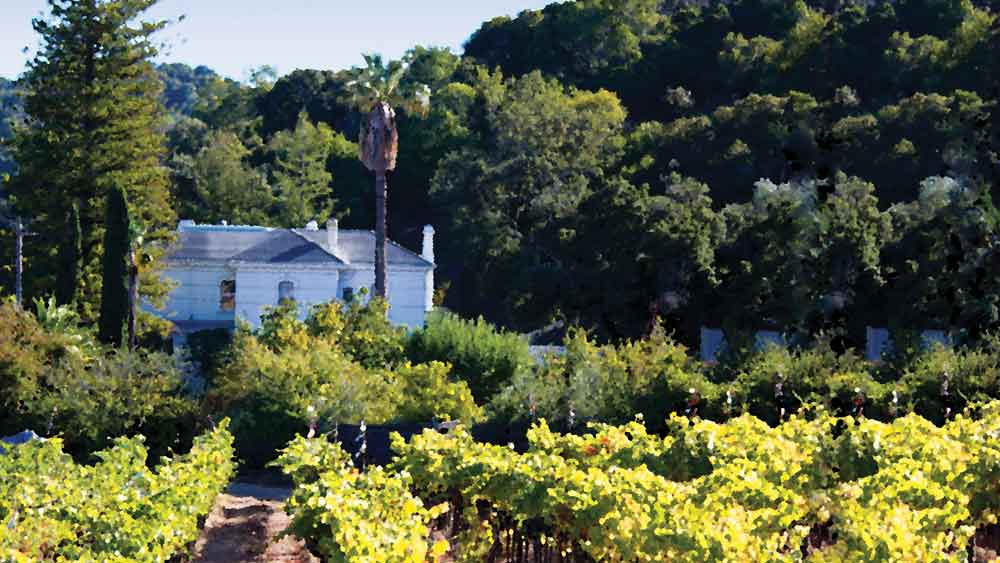
Cows roamed freely on the lands of Rancho de San José in the 1800s. Don Juan Ignacio Antonio Pacheco’s Mexican land grant encompassed 6,668 acres in Northern Marin County, and cattle were the mainstay of the ranch’s business activities. Pacheco also raised racehorses and harvested fruit from his orchards, and he planted a few grapevines, too. Now, almost 200 years later, the cows are a memory and winegrapes are prominent on what remains of Pacheco’s holdings. His great-great-great grandson, Herbert Rowland III, manages the hillside vineyards on the historic property—all within Novato’s city limits.
Rancho history
Ignacio Pacheco (1808-1864) was a grandson of Juan Salvio Pacheco, who came to California with his family in 1776 with the De Anza expedition. The son of the alcalde, or mayor, of San Jose, he was born at Mission Santa Clara and served as a soldier in the Mexican army at the San Francisco Presidio. He became a respected judge following his service, and then, looking north, he turned to agriculture. He requested a land grant and was offered a spread in Sonoma County, where Kenwood is now, but it didn’t suit his purposes. He preferred Marin County for its climate and agricultural potential, so he applied for a larger land grant in the northern part of that county instead. He began living on the rancho in 1834, and Governor Juan Alvarado officially granted the property to him in 1840. Rancho de San Jose stretched from Indian Valley in the west to the shores of San Pablo Bay in the east, and from north of today’s Ignacio Boulevard to St. Vincent’s hill in the south. “It was essentially all of Southern Novato, about 10 square miles,” says Rowland. Pacheco’s rancho was one of four land grants in the area, and the property owned by his descendants, the Rowlands, is the only one remaining in family hands. Notably, it has the distinction of being the oldest estate in California still in agricultural production that has been continuously owned by the same family.
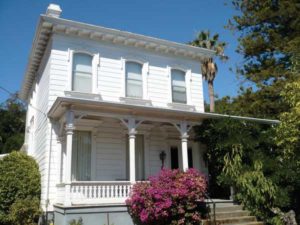
“The 70 acres we’re sitting on is the home ranch,” says Rowland, adding that Gumesindo’s business was raising cattle, primarily dairy and milk cows, and he grew hay on the land that later became Hamilton Air Force Base to feed his beef stock. He also cultivated Mission grapes—and perhaps Concord, whatever the friars who imported the vines could provide—for wine, and he supplied the Roman Catholic Church with sacramental wine as well as making some for his own purposes. The Pachecos did lots of entertaining and hosted legendary barbecues, so it was likely put to good use. Gumesindo, who served as a Marin County supervisor, planted the vines in the late 1800s, and one still exists on an arbor close to the house. “It’s well over 120 years and still producing,” says Rowland.
A new direction
By the mid-1900s, most of the rancho’s lands had been sold, but the ranch house and the 70 acres surrounding it remained in the hands of the family, with Herbert Rowland, the son of Gumesindo’s daughter Abigail, as owner. Abigail eloped with Clarence Rowland in 1909, but later left him to return to the family home with only her son. The property was adjacent to Highway 101, and in the 1950s, the State of California condemned 5 acres so they could build a freeway overpass. “That was state land when I was growing up,” says Rowland. The Department of Transportation, however, constructed an overpass farther south instead, and in the 1960s, after determining that it no longer needed the site, the state decided to put it up for sale. A clause in the original sale agreement with the Rowlands gave the family the right of first refusal, and they took advantage of the opportunity to buy the property back for the amount the state had paid for it. Concrete slabs littered the site; eucalyptus trees and scrub oaks had taken over; and “It was a mess,” Rowland recalls. Then, they learned that the reclaimed property would be reassessed, and they needed to find a use for it. They considered apartment buildings or maybe a gas station, but ultimately, “We decided we needed to get that 5 acres into agriculture,” he says. They were able to take advantage of a tax benefit provided by the Williamson Act—the California Land Conservation of 1965—which allows landowners to restrict property to agricultural use in return for a property tax assessment that is lower than full market value. They applied it to the entire ranch. “It’s the only thing that saves family farms,” says Rowland. “We couldn’t have kept the ranch without it.”
Next, they had to decide whether to raise livestock or grow crops. They tried raising beef cattle, but among the challenges, they got calls from the California Highway Patrol asking them to round up cows that had wandered onto the highway, and so they shelved that idea. “My father enjoyed good wine, as did my mother,” he says, and earlier generations had grown grapes, so they knew they could do the same. They worked with a Marin County farm advisor, however, and government agencies wanted them to grow Christmas trees. Less than enamored with the suggestion, Rowland and his father independently began to explore the possibility of growing winegrapes.
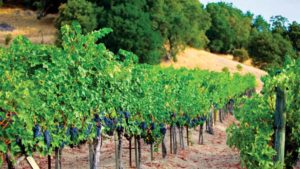
At the time, Rowland was a student at the University of California, Davis. He wasn’t planning to become a vintner but wanted to acquire more knowledge about grapes, and so he enrolled in an introductory viticulture class with Maynard Amerine, a noted enologist, teacher and writer, who offered a class in viticulture and enology. It was the 1960s, before the explosive growth of California’s wine industry, and Amerine was interested in Marin County’s potential for growing winegrapes, so he gave Rowland a project. He instructed him to do research to find the degree days on the family property and the characteristics of the soil, which would allow him to figure out what kind of grapes to grow. The ranch had never kept temperature records, and it seemed like an impossible task until his father suggested that he look east. While he saw San Pablo Bay in the distance, his father saw something closer. Hamilton Air Force Base was just on the other side of Highway 101, and the military keeps that kind of data, so he was able to obtain temperature records going back 30 years for an area that was once part of Rancho de San Jose.
Determining the composition of the soil came next. Amerine gave him a book on plate tectonics, an accepted scientific theory that the earth’s outermost layer is composed of large, solid rock plates. The plates are constantly moving in response to the earth’s subterranean action, and they create rocks that decompose into minerals that become soil. Research led Rowland to discover that the soil contained clay, silty sand and loam—a mélange similar to that in Napa Valley. Amerine also taught him about meso-climates, which are the climates of areas with the same characteristics that can range from yards to miles, such as vineyards and parks. Hamilton was close enough for him to use its temperature data, and Amerine informed Rowland that the climate was similar to Rutherford and advised him to plant Cabernet Sauvignon grapes. He shared the information with his father, but he was well-connected with people in the wine industry, and he had already reached the same conclusion and acquired 1,000 Cabernet Sauvignon grapevines from a friend who had a surplus.
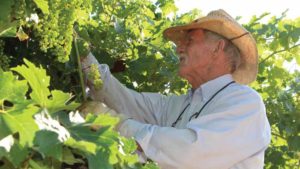
In 1967, the Rowlands started cutting down trees and removing concrete in preparation for planting a vineyard, and in 1969, they began putting the plants into the ground. Members of the family and several friends drilled 1,000 holes, planted the vines and staked, wired and trained them. The Israelis had not yet invented drip irrigation, so they depended on dry farming method to water the fledgling vines. “When we planted, there was no effective way to water grapevines in a location like ours,” he says. “We just stuck them in the ground and watered them with hoses. We didn’t know any better, and it worked.” He explains that once a young grapevine is established, the root develops in such a way that it goes deep, following the moisture until it reaches the water table. The ranch’s well is 30 feet deep, and that’s the depth of the water table, so the roots go far below the surface. In contrast, with irrigation, the root stays close to the surface, because that’s where the water is. “By not having to drip irrigate, we become very dependent on Mother Nature, but it’s a very natural way of doing things,” he says. Crops are larger with irrigation, so dry farming means sacrificing quantity. Rowland reports that some people believe the quality is better, because the nutrients and flavors aren’t diluted. So far, though, no one has proved that theory.
He adds that starting with his father, family members became disciples of slow water doctrine. “You don’t fight water. Water always wins,” he says, so while it’s possible to slow it down, trying to control it is difficult. Taking advantage of nature, the ranch has a reservoir that captures runoff, and the water seeps into the soil and replenishes the water table. When it comes to water, the ranch doesn’t use any unnatural methods and has always been self-sufficient with spring and well water.
Making wine
“By 1973, we had grapes to pick,” says Rowland, although the first harvest was small. Regardless of size, the grape harvest was a cause for celebration, with a group of 60 members of the family and friends, including him and his wife, Debbie, picking grapes and roasting lamb in a big barbecue pit for a feast that included abundant wine, beer and tequila. The yield is usually between six and 12 tons and varies due to dry farming. “It’s roughly proportional to the amount of rain we get,” says Rowland. “If we break even, it’s a good year.”
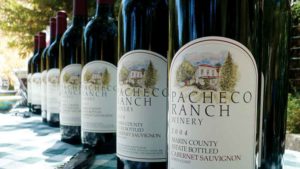
In 1974, Cuvaison Winery, a family-owned winery in Napa Valley that was a leader in modern winemaking, began purchasing the grapes to make a Marin County Cabernet Sauvignon. Cuvaison continued to buy grapes until 1978, and the following year the owners sold the Los Carneros-region winery. Then, rather than finding a new buyer, “We started making our own wine,” says Rowland. They sent Jamie Meves, his brother-in-law, to the University of California, Davis to study fermentation science, which is essentially winemaking, and he became Pacheco Ranch Winery’s head winemaker. “He not only made us proud, he did better than that,” says Rowland. Pacheco Ranch Winery made its own handcrafted wine until 2015, doing the crushing, fermenting, aging and bottling in an old coach house to produce 800 cases of Pacheco Ranch Winery Cabernet Sauvignon a year.
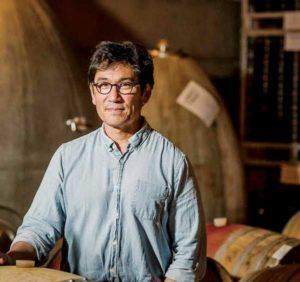
Increasing regulations led to a decision to stop making wine. Rowland still has the bond and license but says it would be too expensive to make all the improvements required to comply with new regulations. Now, he sells the grapes to McEvoy Ranch, a family-owned olive farm and winery in Marin County, south of Petaluma. “They make a delicious Angelica wine using our grapes,” he says, describing the relationship between the two ranches, which are just a few miles apart on opposite sides of Novato, as symbiotic.
“The Pacheco Cabernet Sauvignon goes mostly into the McEvoy Marin Pacheco Ranch Cabernet Sauvignon, with a portion used in Angelica,” says Byron Kosuge, McEvoy Ranch’s winemaker. “Like many good ideas, the Angelica came about through a combination of unusual circumstances and serendipity.” He explains that a heat wave affected a small portion of the vineyard in 2020, producing grapes that were overripe. They were too sweet for dry wine, and so the team at McEvoy Ranch decided to try making a dessert wine. He had only vague ideas how to use the high-sugar juice from the grapes, and he consulted with wine and food expert Darrell Corti, a second-generation Californian involved in the wine industry, who made several suggestions, one being Angelica.
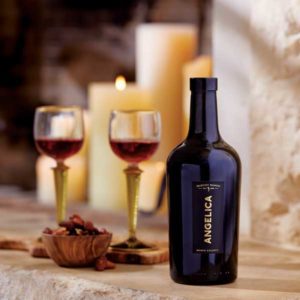
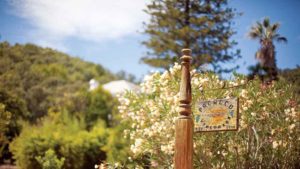
Like ideas in winemaking, Pacheco Ranch is part of an ongoing evolution. Rowland grew up in the historic ranch house as did his father, and although he’s a practicing courtroom attorney with Ragghianti Freitas LLP in San Rafael, trying civil cases, “I’ve always been the vineyard guy. That’s what I really love,” he says. He recalls putting his son, Herbert Rowland III, into a Snugli baby carrier and strapping him to his chest to take him into the vineyard when he was an infant, and every once in a while a branch would snap and hit him, making him howl. Even so, the younger man appears to have inherited his father’s love of the land. Today, he’s the senior vineyard manager for E. & J. Gallo in the Central Coast, but he has made it clear that someday he would like to take over the family vineyard. In addition, he has three grandchildren, and Rowland, their grandfather, says, “I’m going to get them involved in replanting.” Rowland’s children—he also has a daughter, Cassie–and grandchildren will be the sixth and seventh generations to continue the family legacy in Marin County. The next chapters of a rich family history are unknown, but whatever the future brings, the property appears to be in good hands.



